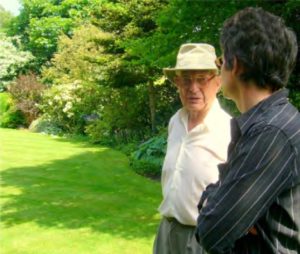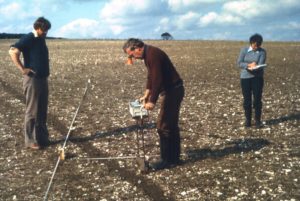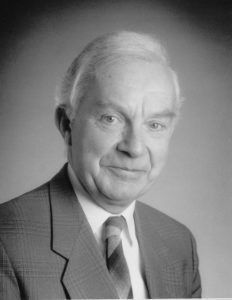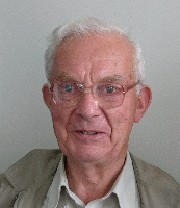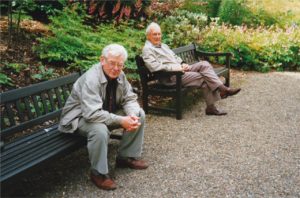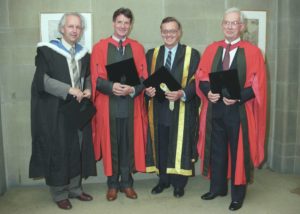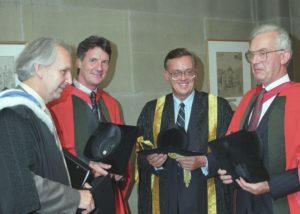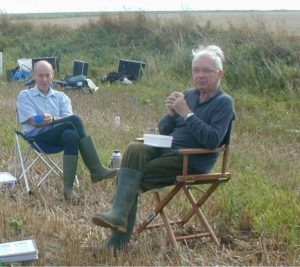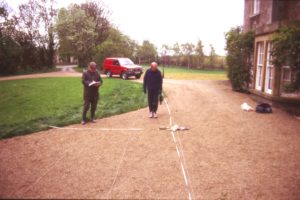It is with great sadness that we have to announce the death of Arnold Aspinall on 8 April 2013. He was an inspiration, as teacher and mentor, to a generation of British archaeological geophysicists. At Bradford, where he set up the first undergraduate degree in Archaeological Sciences, his passing will be deeply felt.
Chris Gaffney (Chairman) and Armin Schmidt (Honorary Secretary)
Thanks from the family
Jane and Lynn Aspinall would like to thank you all for your contributions on this page, as well as the many personal letters that you have sent us.
We are very proud of our modest dad; he was oblivious to the effect that he had had on so many people’s lives. We have enjoyed sharing your memories of him and are deeply moved by your expressions of admiration and, most of all, affection for him.
His passing has left a gaping hole in all our lives; you are all his legacy.
Kind regards
Prof. Arnold Aspinall – ISAP Honorary Member
It is with great sadness that we have to announce to the Society the death of Arnold Aspinall. He was an inspiration, as teacher and mentor, to a generation of British archaeological geophysicists. At Bradford, where he set up the first undergraduate degree in Archaeological Science, his passing will be deeply felt. There will be a tribute to Arnold in the next ISAP Newsletter.
Arnold Aspinall
I am very saddened to announce that Arnold Aspinall has died aged 87.
Arnold was an inspiration to us and one of the driving forces behind the establishing of Archaeological Sciences at the University of Bradford in the 1970s. He was the first head of Archaeological Sciences and he held this position in the 1980s. As you know he kept very close associations with [the Department] after retiring especially through his research in archaeological prospection. His knowledge, experience, leadership, commitment, generosity, friendship and humour will be sadly missed by friends and colleagues not only in Bradford but all over the world.
Obituary for Arnold Aspinall: educator, inspirer and friend
Our four-page obituary for Arnold was published in ISAPNews number 35 and can be accessed from this link.
Here are the closing lines:
He enjoyed talking about gardening, for example with my wife; but when I once started a conversation about his amazing Rhododendron plants he just gave me that wry Arnold look, patted me on the back and said: “It’s no good talking to you about gardening”
To Arnold, from France
I was very sad when Roger Walker announced Arnold’s death to me by mail. I understood how important these news were specially for the “people of Bradford” but also for all the archaeological community. I know from Roger that “many old faces from the past” had come to pay their respect to Arnold on the 23rd of April. From the other side of the channel, Bradford and his leader Arnold are seen as the “Mecca” of archaeological geophysics.
When in 1989 I was invited to finish my PhD at Bradford, this was and still is a key time in my career. Even if I knew the publications of Arnold, the geographical position of Bradford was “somewhere” in a remote place near the North of England and I was a bit afraid with my little car. After 5 months, I have discovered what means
Yorkshire and his accent (isn’t is Chris?), the curries, but more seriously the Department of Archaeological Sciences and his boss.
My first impression was “so british” but I am french and I do not know if british understand what I mean… My second impression was: somebody able to hear, understand and help, whatever are your questions. Arnold followed our experiments with John Skinner about Time-domain magnetisation of soils, as he was doing at the same time with Susan Ovenden’s tank experiments. This was a great time and I am indebted to him for all these reasons. When I came back in 1995 for the first International Conference on Archaeological Prospection in Bradford, this was like coming back for a family party!
Additionnal note by Albert Hesse:
In addition to his considerable and recognized kindness, Arnold played an important part in the survival of our laboratory of Garchy (Centre de Recherches Géophysiques du CNRS, France). Coming from a british laboratory, the international aspect of his unfailing scientific support helped us very much, being a real guarantee in the eyes of our administration. In this respect, he welcomed us (Alain Tabbagh, Michel Dabas and me) several times in Bradford and was confident enough in our work to send at Garchy several students for a long stay during many years: all of them still are among our best colleagues and friends in the discipline.
From a scientific point of view, we must remember that we had with him very fruitfull discussions especially in the matter of resistivity prospection and his so clever idea of the twin electrodes configuration. He will remain for future times an example of human and scientific merit.
Arnold
I will always remember Arnold for his very genuine kindness and patience during my years at Bradford as an undergraduate (1976-80). I recall well that he made geophysics seem fresh and exciting – even the maths! He was always willing to listen to our moans about coursework as well, and somehow forever managed to smooth things out. Arnold’s enthusiasm for research encouraged me to journey into the world of remote sensing and to a semi academic career, and for all this I owe him my deepest gratitude.
From Artefacts to Anomalies: Papers inspired by the contribution of Arnold Aspinall
The papers presented at that day conference in 2006 are available on the ISAP web site. There are many images of Arnold amongst the geophysics data plots.
Below are three of the photographs that were collected then.
- Taken in 1977/8 on the fieldtrip to Winchester surrounded by the year that would graduate in 1980. Arnold doesn’t look too cheerful but was about to get less so as the photo was staged as an excuse to kidnap John Bintliff and throw him in the river! Arnold chased after the kidnap party and persuaded us that it wasn’t such a good idea… (Provided by A Webster).
- A & P Aspinall with J Pocock at Thwing Hillfort (Photograph by T Manby).
- Portrait
University of Bradford
The University of Bradford had published a page [broken link] highlighting the contributions of Arnold Aspinall.
Remembering Arnold
In common with the others who have shared their memories of Arnold here, I will always remember a kind, enthusiastic and supportive colleague and friend. I first met Arnold when I started work at Bradford, fresh from my PhD and realized my new desk was in his office. I approached it with some trepidation as I couldn’t imagine someone who had recently been Head of Department being keen to share with the newest recruit. I couldn’t have been more wrong. He was so generous with his space, his time and his books! His support and encouragement were unstinting and when I got my own office years later, I missed him greatly. During that time we worked together on setting up the MSc in Archaeological Prospection, which was something of which we were both very proud and one of Arnold’s many lasting legacies.
Arnold as “family”
I was a close friend of Arnold’s from 1961 when I joined the Physics staff at the then Bradford College of Advanced Technology. During the 1960s, when the College transformed to University, Arnold developed his interests in Prospection and, with me, in Physical Analysis of archaeological materials. When, about 1970, Bradford University was given leave to expand while maintaining a 60/40 Science/Arts ratio we put to Gordon Brown that you could teach much of Physics through its application to archaeology. He saw the potential and his enthusiasm and drive in committees led to the creation of first a postgraduate course for archaeologists and then an undergraduate course in Archaeological Sciences. Initially we had no archaeologists on the staff but Peter Addyman and, through him, his staff on the York Archaeological Trust, gave positive support for our teaching programmes. Peter’s development of the Trust together with his teaching contributions led to a deserved award of an honorary DSc from Bradford. Likewise, Arnold’s immense contributions to research, teaching and administration as Director of Archaeological Sciences led too to an honorary DSc but from Sheffield University where somehow he found the time and energy to support their development of archaeological science programmes and also their excavations in the south of France, led by Pat Phillips. An honorary DSc was also awarded by Bradford University to Keith Manchester for his (continuing) development of Palaeopathology through the department. Three Doctors of Science is quite a measure of how highly regarded were the pioneering courses in Archaeological Science at Bradford, with Arnold at the helm
Throughout most of his Directorship Arnold suffered from lack of resources to develop Archaeological Sciences as rapidly as he would have wished. This arose because the University restricted the intake to 20 students per annum and because, with such a diverse range of subjects being taught, he had to rely on other departments to provide lectures. He never let those problems overface him and the department was ready to expand to its present strength when next the University was in difficulties over its science numbers.
Arnold always took a keen and genuine interest in those around him and his wonderful recall of personal details put everyone at their ease. Outside his “work” he had a passionate interest in gardening and gardens and was a fount of knowledge on plants, based on years of experience. Our holidays together always included visits to gardens and garden centres where he relaxed totally. We regarded him as “family” and he was to have joined the whole Warren tribe for a holiday in July by which time he expected to have recovered fully from his last serious illness. Sadly, the gods ruled otherwise. They don’t often make people with Arnold’s fine qualities and he will be sorely missed.
The photo shows Arnold and Stanley Warren at Dawyck Gardens near Peebles in 1999.
From China
Express my deep feeling of grief for passing of Arnold Aspinall!
From Israel
It was with deep sorrow that I learned of the death of Prof. Arnold Aspinall. Prof. A. Aspinall was one of pioneers of archaeological geophysics in the world. I must note that a first paper in English that I have read in the former Soviet Union on archaeological prospection was just paper of Prof. Aspinall about the resistivity method application in archaeology.
From my personal communications – he was a top level specialist and nice man…
Remembering Arnold
When I joined Bradford in 1990, Arnold had just handed over as Head of Department to Mark Pollard, having seen the Department through some difficult years. He was a wonderful colleague for a new lecturer to have: positive, supportive and good-humoured. Advice was given when asked for, but without interfering, and a cheerful chat with Arnold really could brighten up a busy day. More than that, he was a link with the pioneering days of archaeological science, and a reminder of how much our crazy discipline has achieved in a couple of academic generations. A good man, fondly recalled.
Personal tribute to a very dear friend of 40 years
Arnold and I were members of an evening class in medieval archaeology in the late 1960s. From that date, my wife Ann and I became good friends of Arnold and Priscilla, his devoted and so supportive wife. In the late 1970s Arnold, Gordon, and Stanley coerced me into teaching osteology and Palaeopathology to undergraduates in Archaeological Sciences. From small beginnings, the subject soon became a compulsory component of the degree curriculum. In late 1980s Arnold was central in convincing the University to create a lectureship in Palaeopathology, and to support an MSc course in Osteology, Funerary Archaeology, and Palaeopathology. This was innovative and became a greatly successful course within the University, and within the international body of Palaeopathology. These achievements were, in large measure, due to Arnold’s vision, enthusiasm, and support. I believe that, without his immense input and foresight, the very significant Biological Anthropological Research Centre within the Division of Archaeological Sciences would not have its current international status and recognition. For this I owe Arnold a huge debt of gratitude. For this achievement the Division and the University as a whole owe Arnold a huge debt.
Arnold was a steadfast friend, he was a willing supporter of hard-working students at all levels, and he was a man devoted to the success and future of Archaeological Sciences at Bradford University. Above all he was a true and honest man, and the quintessential gentleman.
In memory of Arnold
In memory of Arnold
I first met Arnold in Bradford when I came to study for my undergraduate BSc degree in Archaeology but his fame preceded him. I chose Bradford because it was the place to learn more about archaeological geophysical survey, thanks to Arnold. I later returned to Bradford to study for my MSc in Archaeological prospection because, thanks to Arnold, it was still the place to expand one’s knowledge of archaeological geophysics and prospection. By this time Arnold had passed on much of the teaching to Armin Schmidt, whom Arnold respected a great deal, but Arnold still wanted to teach his sciences during practical lectures. Even though he was officially retired Arnold loved experimenting in the geophysics lab and passing on his knowledge and enthusiasm to his students. Some went on to set up specialised geophysical surveys companies on the back of Arnold’s infectious enthusiasm, among them Roger Walker’s Geoscan Instruments (for many years if one was carrying out a geophysical survey one would have been using one of Roger’s instruments) and also Time Team’s very own adopted specialist team, Geophysical Surveys of Bradford or GSB. On television GSB even managed to turn the use a highly technical scientific instruments into a commonly seen and almost understood everyday archaeological occurrence such was Arnold’s legacy. Arnold’s former students appearing on television every week even changed the English language thanks to a new explanation of their activities; thanks to Arnold, they were doing ‘Geofizz’. Google the word ‘Geofizz’ and see how commonly it is now used.
I personally owe Arnold a great deal. When I began the research for my PhD in an attempt to locate evidence of medieval battle and its mass graves using archaeological prospection techniques, it was unfunded and part time. It was the first battlefield survey of its type in Europe and Arnold was one of the very few to completely back this unusual activity. Arnold originally offered to assist me with my geophysical survey and was always joined by John Crummett, or Arnold’s henchman as he was affectionately termed. Eventually Roger Walker joined us on many surveys and we would spend hours criss-crossing the Towton battlefield with numerous surveys. This occurred for over a decade and became a regular occurrence. There was never any funding, but nobody seemed to mind. Some called it the ‘geophysical dream team’ and I was incredibly fortunate to have such assistance and friends. More people joined us including Armin Schmidt and very many students and additional volunteers. Hundreds of people have now worked at Towton, often with Arnold watching over us and helping where possible. We eventually found extensive evidence of battle and additional mass graves. The success of the Towton Battlefield Archaeology Project is down to these early surveys carried out initially with Arnold and John. Like me, countless other individuals, ideas and projects have been inspired by Arnold Aspinall and his dedication to the archaeological sciences. Over the last 15 years Arnold became a close friend. I talked with him a couple of days before he passed away and as usual he was interested to know how certain projects were progressing, but especially how my family was. Because some of my ancestors are called Aspinall I used to tease him about the fact that we might be related. Arnold, however, always made me feel as though we already were. He will be greatly missed and affectionately remembered.
A wonderful person
I was so sorry to hear about Arnold. When I arrived in 1983 at Bradford to work with Keith Manchester, I met a man who was passionate about archaeological science – without him at Bradford many of us (staff and students who have taught, and completed degrees, in Bradford), including myself, would not have achieved half as much as we all undoubtedly have. While his research was focused on archaeological prospection, he was particularly supportive at Bradford of what is now termed ‘bioarchaeology’, and I am most grateful for that. A true gentleman and great character.
Passing of Arnold Aspinall
Arnold was one of the great influencers in my life: from the first year physics classes to my final year where he stood as my supervisor he always offered an uncompromisingly enthusiastic delight in seeing his students learn develop and finally graduate.
Although I went into industry I stayed in touch with Arnold, often taking him out to lunch at some obscure pub miles from anywhere, then back to his house for a tour of the garden and tea.
Always a gentleman, always full of unbridled enthusiasm about his latest project and always keen to hear about my family and work, our outings were always something I looked to immensely.
I will miss our trips, I will miss his enthusiasm and I will miss Arnold. They really don’t make them like that anymore!
God bless Arnold
Thoughts on Arnold
Ever since I started on the Archaeological Sciences degree course back in 1979 I have counted Arnold Aspinall as the benchmark for how to behave as a professional and gentleman. He was a pioneer as an archaeological scientist, an inspiration as a teacher and a mentor to the generations following in his footsteps. Personally I owe him for my career in archaeology for without his guidance and patience I would never have made the transition from Arts A-Level student to graduate in Archaeological Sciences. Even 30 years since I graduated I still apply on a daily basis the scientific principles Arnold instilled in me and which have served me well. Many will write about his academic achievements, which are beyond doubt, but on a more personal level I will always remember Arnold as a kind man, who always had time when I needed it, and for whom nothing was ever too much trouble. He will be missed.
Remembering Arnold
It’s remarkable to read the testimonies already written here and elsewhere about Arnold. Here was a warm, generous and supportive friend to colleagues and students alike. It’s hard to think of a more fitting and genuine tribute to a wonderful man. He was my Head of Department for my first dozen years at Bradford from when I joined in 1978. Through some turbulent times he was a calm and cheerful leader, always convinced of the value of the eccentric enterprise we had set out on. For a Roman archaeologist like me he even managed to initiate me into the hitherto unknown world of the Postgraduate School of Physics. We specially worked together jointly supervising four PhD students, who set about radiating tiny samples of Roman pot and processing the results on very large computers. With Arnold’s blessing and sound advice from the early days we also set off into the field with bulky instruments and lots of recording sheets to try to map out our buried sites. He always had an amused tolerance at our archaeological adventures and was steadfast in support of the attempt to create a special Bradford style of doing archaeology.
At the heart of everything Arnold put his human values. The success of Bradford came fundamentally in creating a welcoming and good-humoured atmosphere in our Department, above all for students. The well-being of students was paramount for him, in a human direct way. That came from Arnold’s own personality. He cared about each of them, and they all knew it and valued it.
As a young colleague, I learned so much from his advice and encouragement, but mostly from his example. He was much loved and appreciated, most of all by those who knew him best. Despite all his academic achievements, I think he would be happy that his best memorial lies in the warmth of the memories of him that live on with his friends.
Arnold
I recall my first interview with him when I arrived to the department of archaeological sciences office in 1987. He had assumed my arrival would be another day. Immediately after we met, he rushed to arrange my stay for the day and whole staying term.
It was a privilege Arnold
I will always remember my first meeting with Arnold when he interviewed me for a place on the undergraduate course at Bradford. He made ‘Arch Sci’ sound exciting and something I could do. He must have spoken to hundreds of potential students by then but I was struck by his enthusiasm and passion. All I can say is that was a privilege to have had Arnold as a teacher.
40 years a friend and a TimeTeam star…
Very sad news that Arnold Aspinall – former Head of Archaeological Sciences at Bradford University and probably the most respected, but understated, archaeological geophysicist – passed away on 9th April 2013. He was a true gentleman in all respects; a quiet academic, who stood head and shoulders above others in his field. He was largely, if not wholly, responsible for the position geophysics now holds in archaeology in Britain and Ireland. He was also a key player in keeping alive (at its time) the most innovative archaeological science department in the UK; probably the world. A man who never sort publicity or personal gain; he loved his field of work, his students and his colleagues. He dedicated his life to his wife, Priscilla, who died far too young, and his children, who are rightly so proud of their native ‘Lancashire/Yorkshire’ father. He looked after more than one generation of students; he always had an open door to discuss both academic and personal issues. He acted as a mentor to all around him (academics and other colleagues) and he inspired study in students at all levels.
I first met Arnold in 1974 – almost 40 years ago – and he changed my life: first as a student and then he was instrumental in my becoming the first ‘commercial archaeological geophysicist’ (with British Gas). He helped my setting up GSB in the mid-1980s; he watched over the development of instruments (with Roger Walker) and the increasing use of geophysical techniques in archaeology. He was actively involved in surveys from the 1960s until very recently (2012) carrying out work into his 80s. I had the pleasure of persuading him to ‘work’ on two Time Teams, when he was in his 70s. (I was grateful that Tony Robinson was overruled when he advocated Arnold should replace me…)
I had the good fortune of presenting a paper in honour of 25 years of ‘his’ department at Bradford and later in celebration of his 80th birthday; most of the time he was too modest to accept recognition of his achievements, but to see him shed a small tear on being awarded (a long overdue) Honorary Professorship was a moving moment for many of his friends…
The tributes will be from far and wide; my personal tribute is simply a large belated ‘thank you’ – something I know he would brush to one side – so I will simply drink a large Highland Park whisky and hope lots of people will join me….”
A Great Inspirer
I was very saddened to hear of Arnold’s death, he was an inspiration to so many people with his enthusiasm for all aspects of life. Despite having achieved so much himself, he was always interested in the news and views of others. I’m sure I wasn’t the only one to arrive at Bradford University without exactly the expected qualifications. The interview involved a piece of timber from Sheffield Manor House, and the question of how it might be dated. A direct approach, which appealed to me and got me hooked on Archaeological Sciences and from that moment. Like many others I have so much to thank him for.
Arnold Aspinall – a gentleman and a scholar
I was sorry to hear of Arnold’s death but I am so glad to have met him. My first real contact with him was on Pat Philip’s excavations in Provence in 1975 where Arnold undertook the prospection – mostly by dowsing. Despite the heat he always seemed interested in what we had to say and what we did; he never let on that we might be tiresome, ignorant and not the witty folk we thought we were. He created no barriers or distance in status or knowledge and he was just so generous with his own knowledge and experience. I was a student at Bradford in 1977-78 where his classes were inspiring both by what he taught and how he taught. He seemed never to need a mark of rank to obtain our attention. I always felt that he consciously refused to see my failure to understand the physics as evidence of stupidity and instead assumed I was just sharing in his own joy of the puzzles within resistivity. I then met him only occasionally as the years passed but he met me by name each time and was always pleased to hear about me. I count myself very privileged to have met him.
Geophys at Duncombe Park 2007 … Peacocks and all!
I was very sad to hear the news that Arnold has gone to the great geophysical survey ground. I got to know Arnold properly, along with Roger and Cath Walker, whilse we were surveying the area around Duncombe Park House, Helmsley. The resulting paper we produced in the Journal of Garden History built on the earlier work Arnold and Roger has undertaken at other stately homes. The weather over the weekend at Helmsley was wonderful, sunny and dry and warm. We basically had the place to ourselves, having promised the then Lord Duncombe that we wouldn’t in any way damage his croquet lawn! The work was progressing well, the equipment, and Roger’s new ‘cart’ were working beautifully. The environment was made all the more picturesque by the presence of a peacock and a few pea hens wandering around, appearing interested in what we were doing. Particularly Arnold, who was being harrassed by the male of the species – being both followed and shown the display of the bird’s tail! As the day progressed, and the data was downloaded, we suddenly realised why Arnold appeared to be so such interest to the peacock ….. he was wearing a combination of browns. The same colouring as the pea hens! Whenever I see the peacock colours or a specimen of the species, I smile, and remeber that wonderful English day, and the Duncombe Park House croquet ‘pitch’ and a worried looking Arnold! A wonderful weekend! And some good results …. under the croquet lawn was a tennis court!!!!!
Arnold was the backbone
Arnold was backbone of the department and ‘father’ to many generations of archaeologists who respected and loved him for his quiet authority, depth of knowledge, and genuine kindliness. Although the department has changed considerably since he retired his loss will be deeply felt by present as well as past staff and students no matter in what part of the world they are now living. Arnold will always be remembered as the man who first got archaeology at Bradford off the ground, developing it from a side-shoot of physics into a multi-skilled academic course. Especially during the early years, when Bradford was virtually the only university to offer a scientific basis to archaeology, graduates had particularly good opportunities to find subsequent employment both in archaeology and in associated disciplines because of their varied practical training. Perhaps most importantly, Arnold’s personality gave the department a family feeling. Students often tend to return for reasons varying from conference attendance to purely social visits, suggesting their time spent as under- or post-graduate is remembered with affection. Those who knew Arnold Aspinall must celebrate the fact that they did, they were fortunate, and in spite of their grief the highest compliment they can now pay to Arnold’s memory is rejoice that he played such a valuable part in so many people’s lives for so many years.
Arnold, you will be missed
Although I knew Arnold for a little over a year when I was a post-graduate student at Bradford in 1980, he has left a lasting impression on me. His old world charm, dry wit and strong intellect, were the hallmarks of this wonderful person. Whenever we subsequently met he always had words of encouragement and would make a wry comment that made me laugh. As has been mentioned, he was a true gentleman and a scholar. Arnold you will be missed.
A FRIEND AND COLLEAGUE FOR MORE THAN 40 YEARS
I first met Arnold in about 1966 when participating in a Workers Education Class to build and fire a series of medieval type kilns in the Bradford-Leeds area, and since then we have been friends and colleagues. Over the years, I frequently visited Bradford as an external examiner for the graduate and undergraduate courses that Bradford established in archaeological science, as well as as an examiner for PhD students. During these visits, I always stayed with Arnold at his delightful house on the edge of Bradford, and enjoyed wonderful hospitability, first from Arnold and his wife, and then, after his wife’s sad early death, from Arnold himself. The resulting evenings with Arnold always ended with enjoying a selection from Arnold’s currently available range of malt whiskies (with which no water was allowed!). More recently, my wife and I have visited Arnold en route to other destinations in Yorkshire and beyond, and we are particularly delighted that we stopped off for lunch with him in his new home in Giggleswich in March 2012 on our way to Yorkshire.
Although our meetings over the years were fairly rare, I will always remember (and will miss) the great warmth of Arnold’s friendship.
COLLEAGUE, FAMILY FRIEND AND MENTOR
I worked with Arnold for over 20 years, in fact he was the reason I went to Bradford in the first place. I joined the University staff late in 1974 as a raw young lecturer and he guided me through the first year or so until I gained my feet, pointed out what was what, who was who, who was to be trusted, and who was to be avoided. He advised me on which students were idiots and which were going places. I think it’s fair to say that between us we had a pretty good track record of getting it right. Thanks largely to Arnold’s nurturing and patronage, there are now Bradford-trained archaeologists ensconced in senior positions all over the country, as university Chairs, Directors of this, Heads of that, and many just enjoying working in archaeology thanks to the ‘Bradford Experience’ that Arnold did so much to create.
He was pretty astute, but never played political games; he worked on the basis that being open, honest and keeping your feet on the ground was the best policy – a policy I’ve tried to follow ever since. He was a true Northerner, and you have to be a Northerner to fully understand what that means. He was also a colleague, family friend and mentor; he was always a person I could ring up for advice even when he was in his 80s. And he never let me down. Thinking about it, and after nearly 40 years in the business, I don’t think I ever heard anyone say a bad word about him, and in archaeology, and in a university environment, that’s not a bad achievement!
Let’s not forget his gardening. He knew more about horticulture than most people have had hot dinners, and keeping the impossibly large garden at Manor Vale in check was another remarkable success. I think that was probably his private world. I had a colleague who remarked that archaeology was very similar to gardening, that both were rather like prayer. I had never thought of that before, but I think it’s probably true – both allow you the privacy to soul-search and to explore.
Arnold and I shared many things: archaeology; scientific solutions to problems; irresponsible dogs; unpredictable offspring; good malt whisky, and Northern Britain. On the downside, he supported Manchester United, but on this occasion I am prepared to excuse that. Arnold, we shall all miss you.
Bradford and Sheffield
Like the other contributors I remember Arnold as a kind and interested scholar who had a major impact of 20th century archaeology in Britain partly through his own work, but especially though the work of those many students he taught and inspired. Bradford is, I think, the only archaeology department in the world which had its origin in a department of Physics. During the late 1960s to the mid-1980s Sheffield and Bradford developed in a parallel and complementary way with Sheffield concentrating on environmental, economic and theoretical approaches, and Bradford on the pure sciences. In those days before the policies of successive governments set university against university in headlong competition for students and research funds, ours was a relationship of mutual respect and close collaboration, and honouring Arnold with an honorary degree in 1992 was the culmination of many years of collaboration with the Sheffield department. From the 1960s Colin Renfrew worked with Arnold in the analysis and characterisation of materials such as obsidian, and later he was carrying out geophysical work on Pat Phillips’ project in southern France. I had a long and happy period (1978-1985) as external examiner dealing with the archaeological aspects of the Bradford undergraduate course, and Arnold occasionally dropped in to see me on my excavations at Aulnat in central France as he travelled through. I never worked with him in the field, but it was a Bradford team which did the vital geophysics on my excavation at Wigber Low in Derbyshire, a team including Gill Bussell, one of the first of the many Sheffield graduates who moved on to Bradford for their postgraduate training and doctorates, while in return we welcomed Bradford graduates for our environmental and prehistory courses. It was a golden age for archaeology in British universities, and Arnold at Bradford played a unique and eminent role.
An inspiration to many
I first met Arnold in 2001 or 2002 when undertaking the MSc Archaeological Prospection course. I remember we were surveying in his back garden with the Pulseekko 1000. At some point, when it came to choosing dissertation topics I must have expressed some kind of interest in earth resistance survey because I ended up working closely with Arnold on a project about the square array. Once my disseratation was done, he was of course insistent that we should publish the work, while I dragged my feet! Over 10 years later, I still get quite excited about the square array and about ERT. I think I have Arnold to thank for that!
More recently I have been looking into the history of archaeological geophysics in Orkney which reads like a whos who of Arnold’s former students. I wasn’t surprised at all to find Arnold himself, where else, but right at the beginning of the story.

